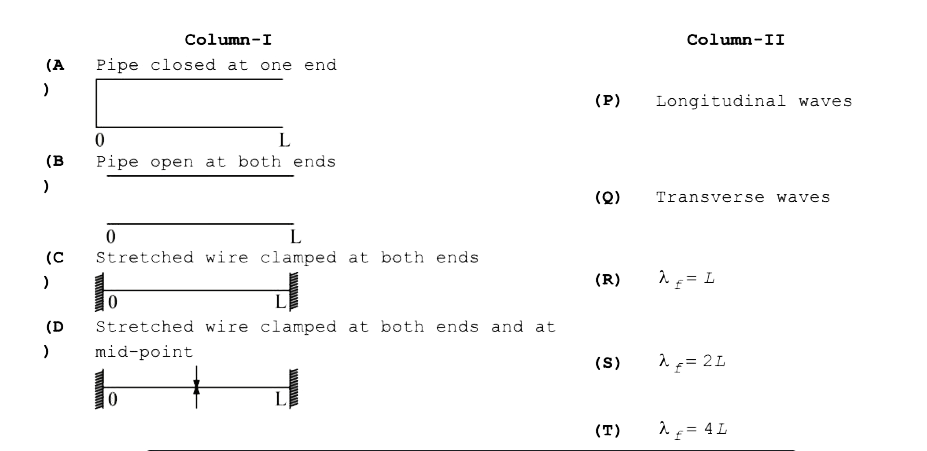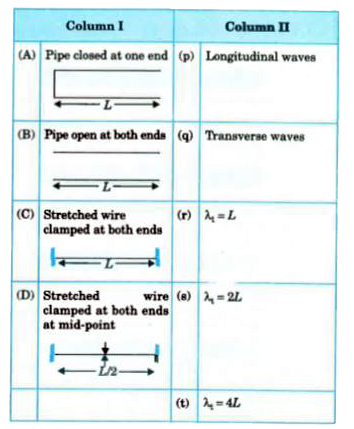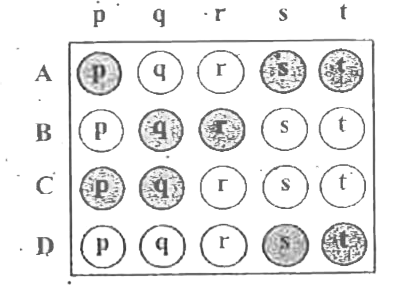Natural frequency of a system is called its fundamental frequency, whose wavelength is denoted as λf. Match each system with statements given in Column-II describing the nature and wavelength of the standing waves.

The correct Answer is:A, B, C, D
A-P,T,B-P,S,C-Q,S,D-Q,R
(A) Sound wave are longitudinal waves λf2=L⇒λf=4L
(B) (A) Sound wave are longitudinal waves λf2=L⇒λf=2L
( c )string wave are transervse wave λf2=L⇒λf=L
(D) string wave are transverse waves λf2=L⇒λf=L
Similar Questions
Column I shows four systems, each of the same length L, for producing standing waves. The lowest possible natural frequency of a system is called it fundamental frequency, whose wavelength is denoted as λt. Match each system with statements given in Column II describing the nature and wavelength of the standing waves.
 View Solution
View SolutionColumn I shows four systems, each of the same length L, for producing waves. The lowest possible natural frequency of a system is called its fundamental frequency, whose wavelength is denoted as λf. Match each system with statements given in Column II describing the nature and wavelength of the standing waves.
 View Solution
View Solution
Knowledge Check
- Question 1 - Select One
An air column, closed at one end and open at the other end, resonates with a tuning fork of frequency f when its length is 45cm,99cm and at two other lengths in between these values. The wavelength of sound in the air column is
A180cmB108cmC54cmD36cm - Question 2 - Select One
Consider the following statements,
I The speed of light does not depend upon the nature of the medium through which it passes.
II The beam of light is deviated or reflected from its original path as it passes from one medium to another.
III When a ray of white light is passed through a prism, the wave with shorter wavelength bends more than the one with a longer wavelength.Which of the following statements is/are true? Choose the correct optionAI and IIBII and IIICIII and IDAll of these
Two wires each carrying a steady current I are shown in four configurations in Column I. Some of the resulting effects are described in Column II. Match the statements in Column I with the statements in Column II and the indicate your answer by darkening appropriate bubbles in the 4×4 matrix given in the ORS.
 View Solution
View SolutionA string of length L fixed at both ends vibrates in its fundamental mode at a frequency v and a maximum amplitude A. (a) Find the wavelength and the wave number k. (b) Take the origin at one end of the string and the X-axis along the string. Take the Y-axis along the direction of the displacement. Take t = 0 at the instant when the middle point of the string passes through its mean position and is going towards the positive y-direction. Write the equation describing the standing wave.
View SolutionVelocity of sound is given by the expression, v=f×λ
Where, v= velocity of the wave,
f = frequency, λ = wavelength
Using the above information answer the following questions
The velocity of sound in air is 344m/sec. What is the wavelength of a sound wave of frequency 32Hz?View SolutionThe section contains one question. Each question contains statements given in two columns which have to be matched . The statements in Column I are labelled A, B, C and D , while the statements in Column II are labelled p,q, r, s and t. Any given statement in Column I can have correct matching with ONE OR MORE statements (s) in Column II . The appropriate bubbles corresponding to the answers to these questions have to be darkened as illustrated in the following example:
If the correct matches are A-p, s and t, B-q and r, C-p and q, and D-s and t, then the correct darkening of bubbles will look like the following .

Match the reactions in Column I with nature of the reactions/type of the products in Column II. Indicate your answer by darkening the appropriate bubbles of the 4×4 matrix given in the ORS.
 View Solution
View SolutionVelocity of sound is given by the expression, v=f×λ
Where, v= velocity of the wave,
f = frequency, λ = wavelength
Using the above information answer the following questions
Calculate the wavelength of radio waves of frequency 109 Hz. The speed of radio waves is 3×108m/sView SolutionIf the intensity of the incident light (whose frequency is greater than threshold frequency) is increased then explain its effect on (i) the maximum momentum that photoelectron could have and (ii) the minimum de -Broglie wavelength that photoelectron could have.
View Solution

